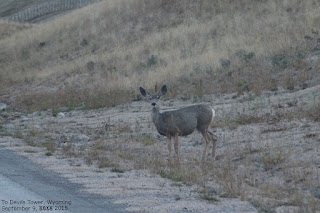We had heard about Devils Tower from
several folks so took the opportunity to check it out on our way
south, since the campgrounds in the Dakota's were closing down for
the winter. The drive from Prune Lake down to Devils Tower was even
quieter than usual in Wyoming – we went 20 minutes at times without
seeing another vehicle! Lots of pronghorns and beautiful country,
though.
Our first glimpse of the tower was
miles away from the park, but it was eye-catching none-the-less. We
played hide-and-seek with it for an hour before we got to the park
entrance and once we were at the visitor center, it was almost too
large to take in.
200 million years ago, the landscape
was very different. Shallow seas came and went, each depositing large
amounts of silt and sand. Over time, this was compressed and
hardened into sandstone and siltstone. Fast forward to 50 million
years ago when Magma was injected into layers of sedimentary rock,
forming the Tower beneath the earth's surface. Millions of years of
erosion have stripped away one and one-half miles of the softer rock
and sediment to bare the Tower as we see it today. The igneous rock
left behind is called phonolite, which is found in Northeast Wyoming
and central
Montana, but mostly in east Africa. As
you can see in some of the photos, much of the original Tower has
broken off and tumbled down around its base.
The Tower and Black Hills area have
been a gathering place for native people for 10,000 years. The
Arapaho, Cheyenne, Crow, Kiowa, Lakota, and Shoshone have developed
cultural and spiritual connections with the Tower and they continue
to pass on those beliefs today. The Kiowa people tell of eight
children – seven sisters and their brother – who were playing in
the forest when suddenly the boy was struck dumb, and turned into a
bear. He chased his sisters and they ran. When they came to the stump
of a giant tree, the tree told them to climb upon the stump. As they
did, the stump began to rise, taking the girls beyond the reach of
the bear. The bear rose against the tree and scored its bark all
around with its claws. The sisters were born into the sky where they
became the stars in the constellation Pleiades.
Vast bison herds once wandered the
valley near the Tower. As the buffalo were hunted to near extinction,
the habitat changed to ranchland. Cowboys drove wild cattle from West
Texas and New Mexico into this area where cattle ranching continues
to be a primary industry.
Two local ranchers first climbed the
Tower in 1893 using a wooden stake ladder, two years later the wife
of one of the ranchers made the climb. Over the next 30 years, as
many as 200 climbs were made using the wooden ladder. In 1937, a
three-man team made the first ascent using modern climbing
techniques. In 1941 a man parachuted to the summit just to prove he
could hit the impossible. His planning wasn't as good as his
parachuting skills, as he was stuck for six days before being rescued
by a party of technical rock climbers. The Tower is still a popular
destination for rock climbers – there must have been a half-dozen
climbing groups each day we were there. Scared me half to death!
Many Northern Plains Indian tribes view the area as sacred and oppose
climbing on the Tower. Tribal representatives have often compared
climbing the Tower to dishonoring a place of worship. There is a
voluntary climbing closure in June out of respect for American Indian
beliefs, which most but not all climbers observe.
And yes, it should be Devil's rather
than Devils, but due to a typo when the proclamation establishing
Devils Tower was published, the apostrophe was left out and the
clerical error was never officially corrected.
Just outside the campground is The
Circle of Sacred Smoke, a sculpture by Japanese artist Junkyu Muto,
whose sculptures are in spiritually significant locations throughout
the world, including Vatican City.
We took a day trip into Gillette, the
nearest town (but still an hour and a half away) and while there,
visited the Rockpile Museum and an overlook at the Eagle Butte Mine.
The museum was a gem and well worth a few hours and a generous
donation. The mine produces low-sulphur coal which is shipped by
train to power plants throughout the West, Midwest, and South United
States. This is the plant that produces the coal we saw while we were
camped at Guernsey back in May of this year.
We had planned on heading over to South
Dakota from here, but we've tarried too long in Wyoming and the parks
are all closing for the season, so will head south and stay a week in
Scotts Bluff, Nebraska, which was near a stopping point on the Oregon
Trail.























































No comments:
Post a Comment